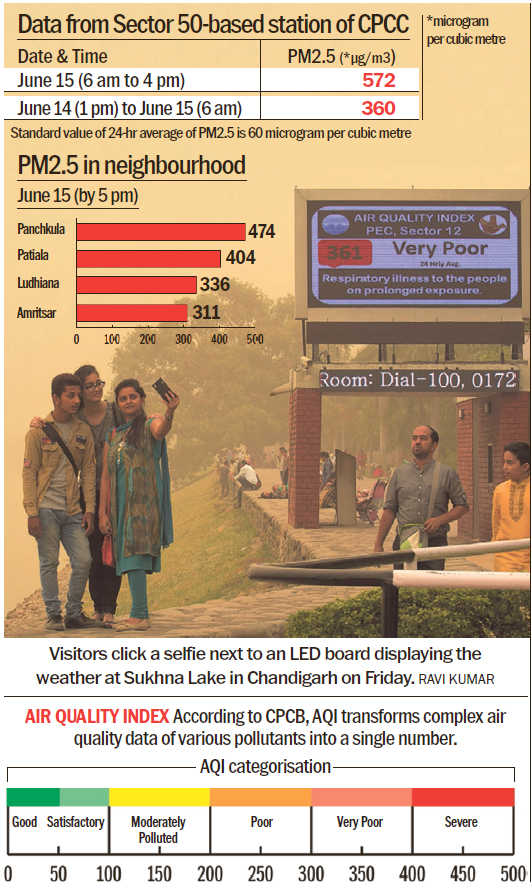
Bhartesh Singh Thakur
Tribune News Service
Chandigarh, June 15
As dust continued to envelop the region for the second day, Chandigarh witnessed the highest-ever concentration of PM2.5, a pollutant which is so fine that it can reach our lungs directly and then the blood system, both on June 14 and 15.
The observatory of the Chandigarh Pollution Control Committee (CPCC) at Sector 50 measured PM2.5 at 572 microgram per cubic metre of air on an average from 6 am to 4 pm on Friday. However, from 1 pm on Thursday to 6 am on Friday, it was 360 microgram per cubic metre.
The standard value of PM2.5 is 60 microgram per cubic metre for a 24-hour period. Scientists at the CPCC said it was unprecedented and the highest ever in the city.
Thursday was equally worse
According to the data provided by the CPCC, its Kaimbawala station recorded PM2.5 at 178 (24-hour average) on Thursday. However, it was 120 at the Institute of Microbial Technology (IMTECH), Sector 39, and 139 at Sector 17 the same day.
If we compare it with the standard value of 60 microgram per cubic metre for a 24-hour period, the concentration of PM2.5 was about three times more at Kaimbwala, two times more at IMTECH and over two times more at Sector 17.
Pollution in neighbourhood
According to the Central Pollution Control Board (CPCB), the average of PM2.5 at 5 pm in Panchkula was the highest at 474 microgram per cubic metre, followed by Mandi Gobindgarh at 440, Patiala at 404, Khanna at 351 and Ludhiana at 336.
Doctor’s advice
Dr Ravindra Khaiwal, Associate Professor, School of Public Health, PGI, said such concentration of dust could cause eye irritation, respiratory discomfort to people suffering from cardiovascular diseases. “Those who have dust allergy or a compromised immune system should avoid going out.”
He advised people to wash their hands and face regularly and cover their face while going outside. “If possible, use the N-95 mask as it blocks PM2.5,” he said.
“Our body has its own fighting mechanism. These dust particles have lesser toxicity than automobile exhaust and particulate matter produced by burning of crop residue,” he said. On the idea of the Panchkula MC sprinkling water on roads, Dr Khaiwal said, “When a vehicle moves, it makes dust fly. Heavier particles settle down but finer ones remain suspended and affect human health. Sprinkling of water settles down the dust, so it is helpful.”
Hopes rest on rain
The Director, Met Department, Chandigarh, Surender Paul, said rain was approaching due to western disturbances and would hit Chandigarh either on Friday night or early Saturday morning. “It could hit northern districts of Punjab any time,” he said.
Dust storms from Rajasthan to blame
Explaining the reasons behind the dust blanket, he said dust storms from Rajasthan were behind it. “The anti-cyclonic circulation in the troposphere has hindered convection and movement of air, making the dust remain around in the region,” he said. “The visibility further slumped to about 1,000 metre on Friday as the moisture rose due to the approaching western disturbances. The water vapours have got trapped in dust particles, which lowers visibility,” he said.
What is PM2.5 and why do we have to worry
Particulate matter of the order of size of 2.5 microns is called PM2.5. According to the World Health Organisation (WHO), PM2.5 can penetrate the lung barrier and enter the blood system. “Chronic exposure to particles contributes to the risk of developing cardiovascular and respiratory diseases, as well as lung cancer, says the WHO website. The particles with a diameter of 10 microns or less (PM10) can penetrate and lodge deep inside the lungs.
Doctor’s advice
- Those who have dust allergy or a compromised immune system should avoid going out
- If possible, use the N-95 mask as it blocks PM2.5
- People to wash their hands and face regularly during such a scenario and cover their face while going outside
The CPCC started counting PM2.5 since 2017 and since then, the figures of June 14 and June 15 are the highest. In view of the high pollution, it has issued an advisory for the public.
- Construction activities, including carpeting of roads, be stopped
- Don’t smoke as it harms not only you but others too
- Sand, soil and municipal waste should not be carried in open trolley/trucks
- Players, athletes, walkers and senior citizens should avoid exercises/walks during these days
- Patients, particularly asthmatic or those suffering from heart and eye ailments, must remain inside. If it is necessary to go outside, they should use masks.
- Parents are advised not to let their children play outside.
- Go to the nearest hospital if you feel breathless or palpitation
Air quality hazardous in Panchkula
Panchkula: The air quality continues to be hazardous in Panchkula. As against the permissible limit of 60 microgram per cubic metre, it was recorded at 488 microgram per cubic metre on Friday. PM2.5 continues to be the primary air pollutant in Panchkula.
- The level of PM2.5 was 488 ug/mg3 (micrograms per cubic metre) on Friday, which was around 500 ug/mg3 on Thursday.
- Rajesh Garia, a senior scientist, the Haryana State Pollution Control Board (HSPCB), said dust particles less than or equal to 10 micrometers in diameter were so small that they could get into your lungs, potentially causing serious health problems. “The gas content is within limits. It is minute dust particles that are causing problem,” he said.
- The MC deployed three fire engines throughout the city to sprinkle water on main roads, trees and road berms to settle down the dust.
- MC Commissioner Rajesh Jogpal said one fire engine was covering the city. The other two covered the Mansa Devi area and and the trans-Ghaggar sectors.
- The dust has been caused due to strong and dusty winds blowing from Delhi and Rajasthan. — Rajinder S Nagarkoti



























